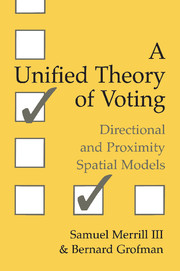Book contents
- Frontmatter
- Contents
- List of Tables and Figures
- Acknowledgments
- 1 Introduction
- Part I Models of Voter Behavior
- 2 Alternative Models of Issue Voting
- 3 A Unified Model of Issue Voting: Proximity, Direction, and Intensity
- 4 Comparing the Empirical Fit of the Directional and Proximity Models for Voter Utility Functions
- 5 Empirical Model Fitting Using the Unified Model: Voter Utility
- 6 Empirical Fitting of Probabilistic Models of Voter Choice in Two-Party Electorates
- 7 Empirical Fitting of Probabilistic Models of Voter Choice in Multiparty Electorates
- Part II Models of Party or Candidate Behavior and Strategy
- Postscript
- Appendices
- Glossary of Symbols
- References
- Index
5 - Empirical Model Fitting Using the Unified Model: Voter Utility
Published online by Cambridge University Press: 04 December 2009
- Frontmatter
- Contents
- List of Tables and Figures
- Acknowledgments
- 1 Introduction
- Part I Models of Voter Behavior
- 2 Alternative Models of Issue Voting
- 3 A Unified Model of Issue Voting: Proximity, Direction, and Intensity
- 4 Comparing the Empirical Fit of the Directional and Proximity Models for Voter Utility Functions
- 5 Empirical Model Fitting Using the Unified Model: Voter Utility
- 6 Empirical Fitting of Probabilistic Models of Voter Choice in Two-Party Electorates
- 7 Empirical Fitting of Probabilistic Models of Voter Choice in Multiparty Electorates
- Part II Models of Party or Candidate Behavior and Strategy
- Postscript
- Appendices
- Glossary of Symbols
- References
- Index
Summary
The best lack all conviction, while the worst are full of passionate intensity.
William Butler Yeats, “The Second Coming”Testing the Proximity and Directional Models of Voter Utility within a Nested Statistical Framework
Theoretically, we have shown that proximity, directional, and intensity components can all be embedded in a two-parameter unified model of the shape of voter utility functions, of which the traditional proximity spatial model, the Rabinowitz–Macdonald (RM) model, and the Matthews directional model are all special cases. In developing this unified model we showed that the RM directional model, despite its name, is best viewed as a mixed model with both directional and intensity components, whereas the Matthews model best represents a pure directional component.
To provide a preliminary test of this unified model, we look at the nature of voter utility functions for major candidates for the U.S. presidency during the period l980–96 by fitting the unified model developed in Chapter 3 to American NES data. In Chapters 6 and 7 we develop and test a unified model of voter choice for these and other data.
Not unexpectedly, by testing nested submodels, we conclude that, in most applications, pure models must be rejected in favor of a model incorporating two or more of the proximity, directional, intensity, or discounting components. Also – like Enelow, Endersby, and Munger (l993) – we provide evidence that different models of utility functions best explain voter utility for different types of candidates.
- Type
- Chapter
- Information
- A Unified Theory of VotingDirectional and Proximity Spatial Models, pp. 67 - 80Publisher: Cambridge University PressPrint publication year: 1999



